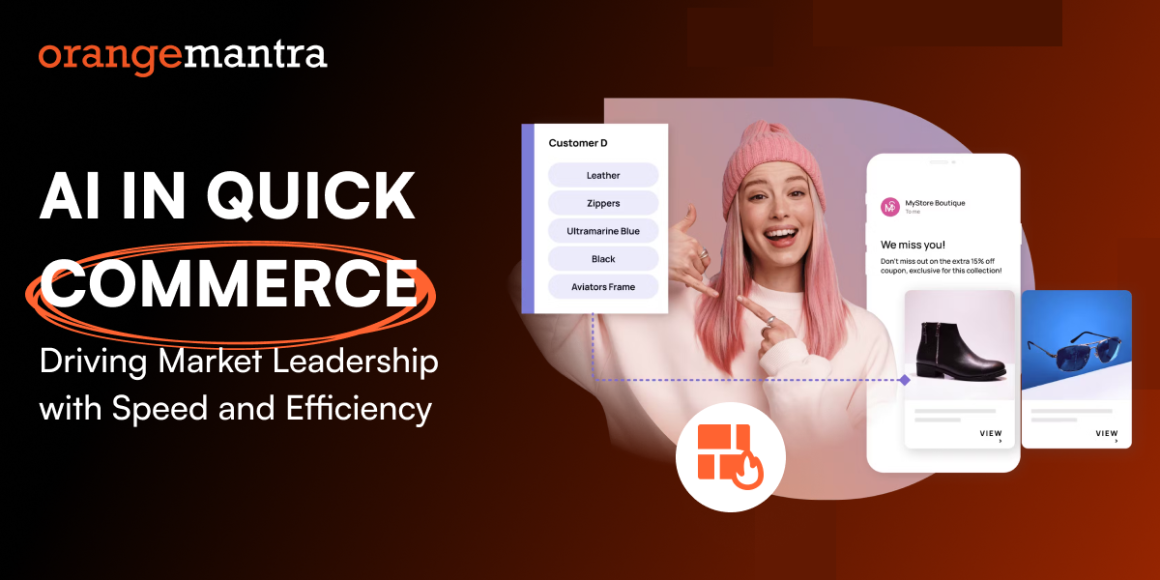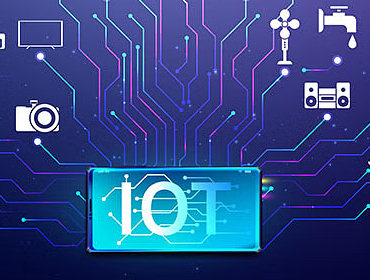Soaring at an annual growth rate of 23.5%, the global Q-commerce market is projected to reach $626.5 billion by 2033 from $75.9 billion in 2023.
A clear indication that a significant opportunity to tap the new market.
However, it is easier said than done. Leading quick commerce companies in India and abroad, such as Gorillas, Zapp, Blinkit, Instacart, and Talabat, all are leveraging AI in quick commerce to improve their operational efficient and deliver better customer experiences.
So, to make it big in this space, tapping AI potential is a must. It will not only bring the needed edge but also help ease doing the business by overcoming some major challenges.
But the question is how?
We are here to answer that today. In this blog, we will explore the most daunting challenges and how AI in Quick commerce can overcome them.
Let’s begin right from the very concept…
What is Quick Commerce: Meaning and Examples
Quick Commerce or Q-commerce is a type of eCommerce that focuses on ultra-fast delivery services. It aims to offer convenience to urban-living customers at speed.
Unlike traditional e-commerce models that typically take days or weeks, Q-commerce deliver products within minutes. We all have seen the ads from quick commerce companies promoting 10-minute or even 9 minutes delivery.
This model is primarily targeted towards customer that prefers convenience over cost and are short on time to go out and shop for essentials such as food, beverages, and toiletries.
For this, quick commerce companies maintain localized warehouses, micro-fulfilment centres, and a decentralized network. All these combined helps them achieve these rapid delivery times.
Despite these benefits and opportunities, quick commerce is not an easy business to do. Read on.
Prominent Challenges Faced by Quick Commerce Companies
Meeting Promises of Fast Delivery
One of the most challenging parts of q-commerce is living up to the hype. Promising ultra-fast delivery is not enough, you need to deliver (quite literally).
This requires impeccable execution on the very ground, managing logistics and inventory with utmost high efficiency.
You need to have hyper-local dark stores, the routes should be optimized to the very last inch (last mile), and the inventory should be on track.
On top of it, you need to deal with external factors like traffic congestion and urban infrastructure that often disrupt timelines.
Furthermore, q-commerce is also known for high customer churn if the promises are half-baked, and you fail to fulfil. Customers readily switch loyalty from one business to another in this fast-paced world.
High Operational Costs but Low Margin
To ensure a successful 10-minute delivery, you need to have a micro-fulfilment at every nook and corner of a city and a significantly large delivery fleet. This is huge, costly and significantly challenging but it is essential as well.
On the other hand, you need to survive on thin margins. This is because you are dealing in essentials that do not come with a huge margin. Plus, free/discounted deliveries and price wars erode profits further.
In short, managing cost and maintaining profit is a challenge.
Inventory & Supply Chain Vulnerabilities
Stockouts – one of the most scaring occurrences for a q-commerce business owner. This directly leads to losses and ruining customer experience that ultimately results in tarnishing brand image and losing to competitors. Q-commerce business must place a mechanism to address this concern through precise demand forecasting and inventory management.
Another associate challenge is of overstocking especially in case of perishables that have a very short shelf life and constitute a significant portion of stocks. The forecasting is crucial to prevent wastage as well.
AI might help; we will discuss it in the next section.
Sustainability Concerns
Lastly, q-commerce businesses also face sustainability challenges. Frequent deliveries increase emissions. And there is packaging wastage concern like the use of single-use plastics for rapid deliveries conflict with environmental goals.
The advent of AI in quick commerce is solving all these issues. In the next section, we have covered it details.
Key Roles and Impacts of AI in Quick Commerce
Inventory Management
To achieve a highly efficient Q-commerce, you need to get two functions right – inventory and logistics.
Let’s first focus on the first one – inventory. You need to have your hyperlocal micro-fulfilment centres located near the high demand sectors and ensure that these should be optimally stocked to meet customer’s changing requirements.
With AI systems tracking product movements in real-time, predict restocking needs, and even suggest product substitutions when an item is unavailable, managing inventory becomes really easy.
This is making Q-commerce an easy-to-do business compared to what normally it is thought out to be – a complex maze of logistics and unpredictability.
This helps business maintain optimal stock levels and minimize stockouts or overstocking.
Optimizing Logistics and Delivery
Now coming to the second aspect, logistics.
As obvious, just maintaining the right amount of inventory is not enough but you need to deliver. And for this, you need to have a robust logistic setup and meticulous execution.
This is where AI algorithms are changing ground realities – quite literally!
They identify and plan the best delivery route on the very ground. The underlying algorithm taking factors like traffic patterns, delivery locations, and real-time road conditions into account to come up with the best route possible to ensure delivery under 20 minutes (if not 10). Some examples are Gorillas, Zapp, Blinkit etc. are capitalizing on AI’s capability for route optimization.
This is how the intelligent technology is helping businesses fulfil the promise of near-instant delivery.
Automation in Warehousing and Fulfilment
However, while just placing a warehouse and setting up an un-interrupted delivery pipeline is not enough you also need to the right tools and technologies to fill the gaps in-between.
AI-powered automation is helping quick commerce business manage order and achieve collaboration across team.
It is also optmizing workflow right from order placements to picking and packaging and then order delivery.
Accurate Demand Forecasting
With capabilities like predictive analytics, demand forecasting and decision making, AI algorithms analyse vast amounts of data, such as historical sales, seasonal trends, and external factors like weather or local events and predict demand accurately.
This foresight helps Q-commerce business ensure product availabilities, better inventory placement and, the most important, minimizing delays.
Enhancing Customer Experience through Personalization
On the customer front, Q-commerce businesses are deploying AI to offer hyper-personalized customer experience. The technology analyses customers’ data such as their browsing history, purchase patterns, and preferences to provides personalized product recommendations.
This eases and improves their shopping experience and increasing the chances of purchase. This adds to customer loyalty leading to repeat purchase and an increase in the basket value overtime.
Ensuring Operational Efficiency and Compliance with Digital Twin Technology
An additional front where AI is helping Q-commerce businesses is with the use of digital twin technology.
With the help of AI-powered computer vision, business create a digital twin of warehouse in real-time. This facilitates remote monitoring and tracking of human productivity, theft avoidance, better safety and compliance. Moreover, this technology can easily be scaled to cover potentially thousands of distributed micro-warehouses.
Improving Sustainability
Q-commerce indeed delivers convenience at speed. However, there have been concerns and backlash for the negative impacts of their practices. This includes
- The increase in greenhouse gas emissions due to the high number of delivery vehicles on the road.
- Higher energy consumption and carbon footprint.
- Increasing number of wasted resources and packaging.
With AI’s delivery route and track energy consumption optimization, the environmental impact will be significantly reduced.
Fraud Detection and Prevention
Given the high transaction volumes and rapid fulfilment cycles, Q-commerce are bound to attract cybercrime perpetrators. They would try to exploit system vulnerabilities, intercept payment data, or manipulate order flows for fraudulent gains.
AI models bring high precision with in detecting anomalies in transactions and flagging suspicious activities. Thereby, safeguarding both customers and businesses.
Conclusion
Q-commerce is a modern-day business model; hence, it can never succeed without modern tech intervention.
And with the power of AI in quick commerce, the future of custom ecommerce website development business models is strongly positioned to bring convenience at speed to the customers.
AI is optimizing delivery networks, forecasting accurate demands, and bringing hyper-personalized shopping experiences.
Businesses who adopt early with take an unmitigable lead.
FAQs
Q1. Who is the top Software development quick commerce companies in India?
Top quick commerce app development companies in India include Orangmantra, Mobibiz, and MobiIndia that have significant experience in eCommerce and app development domains with a strong clientele and proven track of delivered project in q-commerce.
Q2. What is quick commerce?
Q-commerce or quick commerce means an ultra-fast product delivery model wherein customers can order their requirements through and eCommerce app and get it delivered in matter of minutes.
Q3. What is role of AI in Quick commerce?
AI is helping quick commerce business automate and optimize operation for faster delivery and better workflows, including inventory and warehouse management.
























